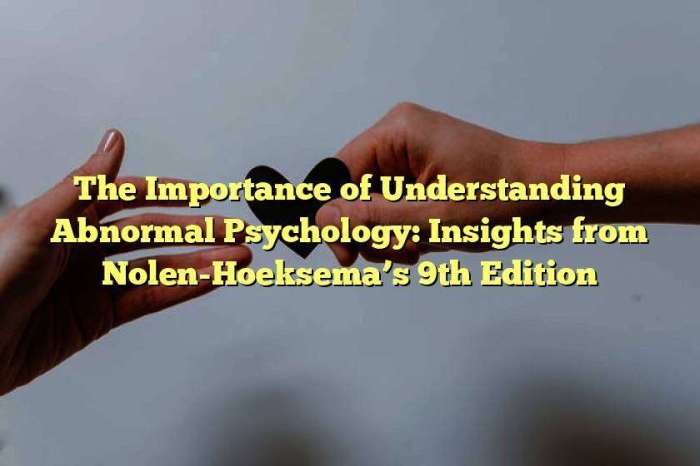Abnormal psychology 9th edition nolen-hoeksema – Abnormal Psychology 9th Edition by Nolen-Hoeksema delves into the intricacies of abnormal psychology, providing a comprehensive examination of its scope, historical development, theoretical perspectives, classification of mental disorders, assessment techniques, treatment approaches, and preventive strategies.
This seminal work offers a thorough understanding of the field, making it an invaluable resource for students, researchers, and practitioners alike.
Introduction: Abnormal Psychology 9th Edition Nolen-hoeksema

Abnormal psychology is the scientific study of abnormal behavior. It seeks to understand the causes, symptoms, and treatment of mental disorders. Abnormal psychology is a relatively young field, with most of its development occurring in the past century.
The historical development of abnormal psychology can be divided into three main periods: the pre-scientific period, the scientific period, and the modern period. The pre-scientific period lasted from ancient times until the late 18th century. During this period, mental disorders were often attributed to supernatural causes, such as possession by demons or witchcraft.
The scientific period began in the late 18th century with the work of Philippe Pinel, who argued that mental disorders were caused by natural factors, such as brain damage or psychological trauma. The modern period began in the early 20th century with the development of psychoanalysis by Sigmund Freud.
Psychoanalysis emphasized the role of unconscious processes in the development of mental disorders.
Theoretical Perspectives

There are a number of different theoretical perspectives in abnormal psychology. The three main perspectives are the biological perspective, the psychological perspective, and the sociocultural perspective.
Biological Perspective
The biological perspective focuses on the role of biological factors in the development of mental disorders. Biological factors include genetics, brain chemistry, and neuroanatomy. Research has shown that there is a strong genetic component to many mental disorders, and that certain brain chemicals, such as serotonin and dopamine, are involved in the development of mood disorders and psychotic disorders.
Psychological Perspective
The psychological perspective focuses on the role of psychological factors in the development of mental disorders. Psychological factors include personality traits, coping mechanisms, and life experiences. Research has shown that certain personality traits, such as neuroticism and introversion, are associated with an increased risk of developing mental disorders.
Additionally, stressful life events, such as childhood trauma or bereavement, can also increase the risk of developing mental disorders.
Sociocultural Perspective
The sociocultural perspective focuses on the role of social and cultural factors in the development of mental disorders. Social factors include social class, ethnicity, and gender. Cultural factors include values, beliefs, and norms. Research has shown that there are significant differences in the prevalence of mental disorders across different cultures.
For example, anxiety disorders are more common in Western cultures than in Eastern cultures.
Classification of Mental Disorders
The Diagnostic and Statistical Manual of Mental Disorders (DSM-5) is the primary diagnostic tool used by mental health professionals to classify mental disorders. The DSM-5 is published by the American Psychiatric Association and is updated every few years to reflect the latest research on mental disorders.
The DSM-5 classifies mental disorders into several different categories, including anxiety disorders, mood disorders, psychotic disorders, and personality disorders. Each category of mental disorders has its own set of diagnostic criteria. For example, the diagnostic criteria for generalized anxiety disorder include excessive worry and anxiety that is difficult to control, and that lasts for at least six months.
Assessment of Mental Disorders

The assessment of mental disorders involves a variety of methods, including clinical interviews, psychological tests, and neuroimaging techniques.
Clinical Interviews
Clinical interviews are the most common method of assessing mental disorders. During a clinical interview, a mental health professional will ask the patient about their symptoms, their history, and their current life circumstances. The mental health professional will also observe the patient’s behavior and appearance.
Psychological Tests
Psychological tests are used to assess a variety of psychological factors, such as personality traits, coping mechanisms, and cognitive abilities. Psychological tests can be administered by a mental health professional or by a trained technician.
Neuroimaging Techniques, Abnormal psychology 9th edition nolen-hoeksema
Neuroimaging techniques, such as MRI and PET scans, can be used to visualize the brain and to identify abnormalities that may be associated with mental disorders. Neuroimaging techniques can also be used to track the effects of treatment on the brain.
Frequently Asked Questions
What is the scope of abnormal psychology?
Abnormal psychology encompasses the study, diagnosis, and treatment of mental disorders, aiming to understand their causes, symptoms, and effective interventions.
How has abnormal psychology evolved historically?
Abnormal psychology has undergone significant historical development, from early philosophical and religious perspectives to modern scientific approaches, including biological, psychological, and sociocultural models.
What are the major theoretical perspectives in abnormal psychology?
The major theoretical perspectives in abnormal psychology include the biological perspective, which focuses on genetic and neurobiological factors; the psychological perspective, which emphasizes cognitive, emotional, and behavioral processes; and the sociocultural perspective, which considers social and environmental influences.
How are mental disorders classified?
Mental disorders are classified using the Diagnostic and Statistical Manual of Mental Disorders (DSM-5), which provides standardized criteria for diagnosing and categorizing mental health conditions.
What are the common methods for assessing mental disorders?
Common methods for assessing mental disorders include clinical interviews, psychological tests, and neuroimaging techniques, each providing valuable information for diagnosis and treatment planning.